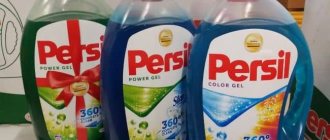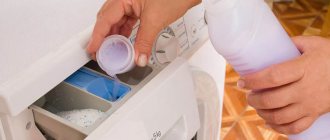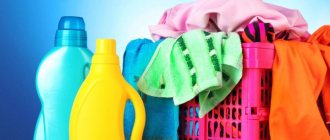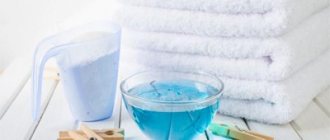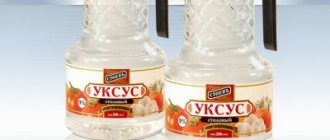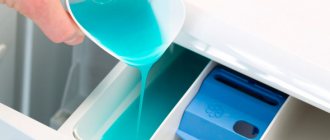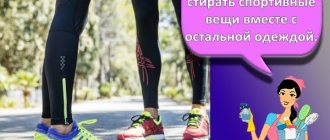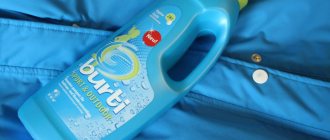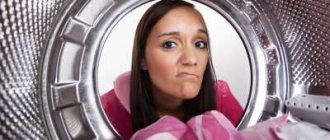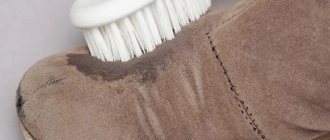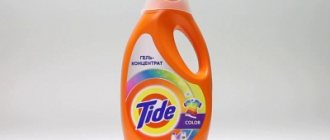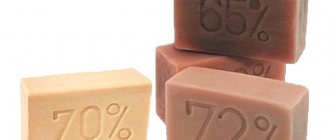Gel, or liquid washing powder, is a homogeneous mass based on surfactants (surfactants), chemical bleaches, enzymes, and alkali. You can make laundry gel with your own hands from available products - baking soda, citric acid, green tea, laundry soap, essential oils, etc. Homemade detergents are as effective as store-bought powders. They are easily washed out of fabrics and remove stubborn stains. If necessary, additives that cause allergies can be excluded from the gel.
Benefits of gels
Self-made laundry gels have many advantages over store-bought ones.
- Absence of surfactants
In store-bought laundry detergents, one of the main ingredients is surfactants. In fact, they are aggressive synthetic substances that have a negative effect on the skin and increase the rate of tissue wear. There is no such component in homemade laundry detergents.
- No phosphates
Many commercial gels and washing powders contain phosphates or their derivatives. They are needed to remove stubborn dirt and stubborn stains.
In addition, they negatively affect the human body, namely:
- have a negative effect on the skin;
- depress the nervous system;
- reduce immunity.
REFERENCE! Phosphates can get into gels prepared by yourself only if they are specially added.
- Washable at any temperature
Most commercial laundry detergents can only be used in warm or hot water. This is due to the fact that the components of the drug begin to act only when heated. DIY remedies are effective even in cold water.
- Price
Homemade gels are much cheaper than store-bought ones. To store self-made products, you can use bottles left over from finished purchased products.
- Hypoallergenic
Do-it-yourself gels consist of only a few components. During the cooking process, all components can be controlled and you can not add those to which you are allergic.
Do-it-yourself washing powder for an automatic washing machine: 7 recipes
To make laundry detergent at home, in addition to the ingredients, you should prepare materials and tools. You will need:
- mixing container (bucket, plastic container);
- container with a lid for storage (glass, plastic);
- mixing spatula or spoon;
- fine grater;
- measuring cup or washing powder dispenser.
In accordance with the purpose (for whitening, children's clothing, disinfection), different mixtures are prepared, differing in the number of constituent substances. Below are seven of the most used recipes.
With soda
Peculiarities. There are several options for preparing washing powder from laundry soap and soda. In fact, none of the homemade powders can do without these components, together or separately. The components enhance each other's action. For washing, 72% soap (tar, baby, laundry), ground on a grater, is best suited.
Components:
- baking soda - 500 g;
- soda ash (linen) - 400 g;
- soap - 200 g;
- aromatic oil (optional).
How to do
- Mix crushed soap with types of soda.
- Stir (shake in a closed jar).
- If desired, add a drop of oil and stir again.
Baking soda is more aggressive than baking soda. To enhance the cleaning effect, it is recommended to completely replace the food powder with calcined one. Baking soda dries out the skin, so rubber gloves should be used when washing by hand.
With vinegar
Peculiarities. A powder for washing clothes is prepared from soap and soda powder, with the addition of 9% vinegar. This will help soften the water and preserve the color of the fabric. Only clear vinegar should be used, otherwise the pink or caramel color will remain on the laundry.
Components:
- soap shavings - 150-200 g;
- baking soda and laundry soda - 200 g each;
- vinegar - two tablespoons;
- fragrant oil.
How to do
- Mix two types of soda with shavings.
- Pour in vinegar.
- Add three to five drops of oil to eliminate the vinegar smell.
With borax
Peculiarities. Borax is a disinfectant that is used as a thickener or cleaner. It is a powdery substance used in dry or diluted form. Borax can be replaced with boric acid, sold in pharmacies. Borax will make an effective DIY laundry detergent for children's clothes.
Components:
- shavings of coconut or laundry soap - 200 g;
- borax - 200 g;
- baking soda - 500 g;
- aromatic oil - if desired.
How to do
- Mix the shavings with soda and tetraborate.
- Add oil if desired.
- Dry the mixture next to the battery.
- Pour into a suitable container.
- Before use, dilute with water and pour into the car.
If a liquid boron solution is used, adding one or two teaspoons is sufficient. It is better to store the mixture in a closed container.
From citric acid and soap
Peculiarities. The composition preserves the color of the fabric, but corrodes various contaminants. Lemon juice gently cleans silk and wool items. After washing, the laundry acquires a pleasant light aroma.
Components:
- citric acid - three tablespoons;
- laundry soap - one bar;
- baking soda and baking soda - 500 g each;
- salt - two tablespoons.
How to do
- Rub the soap.
- Pour two types of soda into the shavings.
- “Salt” and add acid.
- Stir, pour into a jar with a lid.
- If desired, add fragrance oil for scent.
Soda has the property of bleaching fabrics and removing color. Therefore, its amount can be reduced, or not used at all for colored items.
With peroxide
Peculiarities. The solution whitens clothes. It can be prepared in advance and stored in the refrigerator, but no more than a month. Before washing, wet the stains with the solution and then add it to the machine.
Components:
- hydrogen peroxide - one glass;
- vinegar solution - half a glass;
- lemon juice - one tablespoon;
- water - half a glass;
- natural flavoring - optional.
How to do
- Mix peroxide with water.
- Add vinegar solution and juice.
- Add a few drops of aromatic oil.
- Stir and pour into a convenient bottle.
Homemade stain remover is made from peroxide, baking soda and dishwashing liquid. All ingredients are mixed in equal proportions (one tablespoon at a time). The mixture is applied to the stain and rubbed into the fabric with a sponge or brush. After two minutes, the product is washed off, and the item is washed in the machine in the usual way.
Laundry capsules
Peculiarities. From peroxide, soda powder, vinegar solution and magnesium sulfate (sold in pharmacies) you get dry tablets that are placed in universal containers, suitable for full washing, including cleansing and conditioning.
Components:
- laundry soda - 350 g;
- laundry soap - one bar;
- magnesium sulfate - two tablespoons;
- peroxide - three tablespoons;
- vinegar solution (9%) - 50 ml;
- fragrance oil;
- baking tray;
- parchment;
- molds (for ice cream or “bombs”).
How to do
- Rub the soap.
- Add sulfate and soda.
- Add peroxide and stir.
- Pour in the vinegar solution and add a drop of oil.
- Stir until the mixture resembles wet sand.
- Prepare a baking sheet, cover with paper.
- Use molds to make semi-circular tablets.
- Place on a baking sheet and dry at 100°C for several minutes. You can do without an oven by leaving the tablets to dry for a day.
Liquid product
Peculiarities. With a little time, it’s easy to prepare liquid laundry detergent yourself. The consistency is similar to a thick gel.
Components:
- laundry soap - 200 g;
- borax - half a glass;
- laundry soda - one glass;
- water - by eye;
- aromatic oil - one teaspoon.
How to do
- Pour the grated soap into the pan.
- Pour water until the liquid completely covers the chips.
- Cook the mixture over low heat until a cloudy, thick solution is obtained.
- Boil half a bucket of water.
- Add borax, soda, and warm soap.
- Stir, add water to the brim.
- Cover with a lid or board and leave for eight hours.
- Add oil to the cooled solution.
- Pour into suitable bottles and store.
Mustard is another home remedy that deals with various stains and whitens laundry. Mustard is not used as a washing powder in an automatic machine (it will swell and clog the drains); it is only suitable for hand washing, when you wash things yourself. The laundry is soaked in a mustard solution, individual stains are treated with mustard paste (a mixture of powder with a small amount of water).
Disadvantages of homemade gels
You need to spend your time preparing washing gels yourself, and also have containers to store it. In addition, you must strictly follow the cooking technology. But such gels also have their drawbacks.
Among the components of almost all of these products is soap. This ingredient does not dissolve well during washing and also does not foam well, especially if this happens in cold water.
REFERENCE! The best results can be achieved at a temperature of 40ºC, although it can also be used in cold water.
Baking or soda ash. The ingredients of homemade washing gel often include soda ash. This substance has a big drawback - it washes out the paint, which makes things fade, especially if they are washed often.
An alternative can be baking soda. But it also has a disadvantage - the washing efficiency decreases when replacing soda ash with baking soda.
Stains that cannot be treated with homemade gel. Even homemade gels rich in composition cannot cope with all types of stains. They cannot remove stains from the following:
- tea;
- coffee;
- juices;
- chocolate;
- fruits;
- grass and more.
To get rid of stubborn stains, it is better to use a commercial stain remover.
Recommendations for use
The main condition is not to abuse the prepared products and not to put them in a machine like an automatic machine for more than 30-40 g. The powder foams perfectly, but this is bad for the machine: the pipes and hose instantly become clogged with foam. It is advisable to use powders for manual washing and for semi-automatic machines. After washing, rinse the item in plain water to remove any remaining product from the fabric.
If you are going to wash items made from delicate fabrics, then first try the product on the wrong side and on an inconspicuous part. Nothing bad happens to the fabric, which means you can safely wash the item with powder. Laundry soap and soda together can cause the fabric to lose color over time, so try to wash the item with a homemade product no more than once every 2-3 weeks.
On a note! You can store homemade powder in a glass or plastic container, but with a closing lid.
How to use - features
- Where to pour washing gel? It is recommended to pour homemade gel not into the powder container, but directly into the drum. This will prevent the product from smearing on the walls of the tray.
- To get the best washing effect, it is better to pre-soak the laundry.
- Amount of gel used:
- for 4 kg of clothes - from 0.5 to 1 cup.
If the stain is difficult to remove, then the norm can be increased by 150 ml.
- The gel can be used for all types of washing, both manual and machine.
Soda + peroxide + detergent
Often underarm marks appear as a result of using cosmetics such as deodorants.
Take 1 spoon of dishwashing detergent, 2 - sodium bicarbonate and 4 - hydrogen peroxide.
A paste is made from these ingredients and applied to the problem area for at least 2 hours.
After this, the clothes are washed.
The method is suitable for removing sweat stains on white clothes. For bright things you need to do a test (from the inside out). With this test it will become clear whether the item will fade.
Recommended for you:
How to use baking soda and superglue for gluing and cleaning at home
Detergent reviews
Each housewife can choose the best recipe for preparing washing gel based on her preferences. This is possible thanks to a large number of recipes. Housewives often complain on the forum that homemade products are not as effective as store-bought ones. Linen does not wash well and loses its color.
REFERENCE! But for those people who are prone to allergic reactions, you need to be sure that the detergent will not harm your health. For them, making their own laundry detergents is the only way out.
Useful tips
- If it is necessary to wash clothes that are too dirty, the required dose of the product must be increased. This also needs to be done if the tap water has increased hardness.
- Washing will be more effective if the laundry is pre-soaked.
- Multi-colored items should be washed at a water temperature of 40 0C.
- Old stains must be pre-soaked.
- If the amount of gel during washing has been increased, then the additional rinse function must be used.
- Don't be afraid of the vinegar smell. It disappears very quickly while things dry.
- Homemade gels do not pose any threat to the internal parts of washing machines.
- Gels must be stored at room temperature, as they can thicken greatly in the cold.
- Before preparing the detergent, you need to stock up on containers into which it will be poured.
